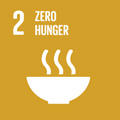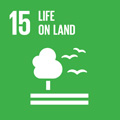- Docente: Luciano Cavani
- Credits: 6
- SSD: AGR/13
- Language: Italian
- Teaching Mode: Traditional lectures
- Campus: Bologna
- Corso: Second cycle degree programme (LM) in Planning and management of agro-territorial, forest and landscape (cod. 8532)
-
from Sep 18, 2024 to Dec 13, 2024
Learning outcomes
At the end of the course, students should have gained the knowledge of the main instruments for chemical and biochemical evaluation of soil quality. Particularly, students should be able to:
- choose the most suitable soil quality indicators to describe soil quality depending on pedo-climate as well as end use;
- evaluate and understand analyses related to soil chemical, biochemical and functional properties;
- evaluate the impact of anthropic and natural events on soil chemical and biochemical properties.
Course contents
Prerequisites: the student who accesses this course must have a good preparation in the fundamentals of soil science. He also knows the basics of soil chemistry, agricultural biochemistry and microbiology.
Syllabus: Knowledge and understanding of soil properties is fundamental for evaluating its quality. The course therefore addresses the most relevant conceptual aspects for understanding the soil quality assessment process, starting from the choice of the indicators to measure, passing through the methodologies for their determination, up to the explanation of the final assessment and concluding with the necessary agronomic actions to restore it. The teaching is integrated with the course of Management of pollutants in the soil-water-plant-system (Module held by Prof. Ilaria Braschi) and together they provide the knowledge and tools for a correct evaluation of the chemical and biochemical quality of the soil (Integrated Course) .
1. INTRODUCTION AND BASAL CONCEPTS (6 hours)
Role and functions of soil in the maintenance of environmental global equilibria. Multi-functionality of soil system. Definition of soil quality. The concepts of indicator and indexes of soil quality. Main soil quality indicators and indexes. Processes, functionality and ecosystems services. Utility and futility of soil quality assessment. Metadata: an essential component for interpreting soil quality measurement.
2. INDICATORS OF SOIL QUALITY (20 hours)
2.1 Basal indicators– the degree of reaction (pH), the texture, the bulk density, the stability of structure, the water availability, the cation exchange capacity, the electrical conductivity.
2.2 Indicators based on nutrients – The “pools” of elements in soil, and their mobility. The determination of main nutrients (N, P, S, K, Mg) in soil. Trace element analysis: total and extractable fractions, sequential extractions. Relationships between soil physico-chemical characteristics and trace element bioavailability.
2.3 Indicators based on soil organic matter – The soil organic matter as a soil quality indicator: conceptual aspects. Chemical and physical fractionation of soil organic matter and identification of C and N pools at different stability levels. Relationships between soil chemical and physical fractions and soil quality.
2.4 Biochemical indicators – Soil microbial biomass. Soil microbial activity. Soil respiration. The enzymatic activities of the soil. Ecophysiological and ecostoichiometric indices. For all these indicators, the methodological aspects, the interpretation of the results and the variation factors will be addressed.
3. SOIL QUALITY ASSESSMENT AND MANAGEMENT (10 hours)
Evaluation and management of soil quality in agricultural and forestry systems: examples and case studies of monitoring, evaluation and restoration of soil quality, with reference to the sustainable management of soil quality and the recycling of biomasses in agriculture. During the presentation of the case studies, regulatory and legislative aspects at local, national and European level will also be addressed.
4. EXERCISES (24 hours)
The exercises of the course are organized: in exercises activities in the teaching laboratories of Chemistry, Agricultural Biochemistry and Feed Technology (Lab CBA), and ICT and multimedia (Lab ICT).
4.1 Lab CBA - exercises are focused on: sampling strategies; sample collection, storage and preliminary handling; soil chemical and biochemical parameters analysis: microbial biomass determination, soil basal respiration, ecophysiological indexes, catalytic activities.
4.2 Lab ICT - exercises are employed to analyze and discuss the data obtained in the Lab CBA, and their meaning in terms of soil quality.
Readings/Bibliography
The didactic material will be provided by the teacher and made on-line available, specific reading will be indicated during the course.
Suggested textbooks:
(A) Soil quality:
- Karlen D.L. et al. (ed.), Approaches to soil health analysis. Wiley, 2021.
- Paul E.A. (ed.), Soil microbiology, Ecology, and Biochemistry. 4th edition, Academic Press, 2014.
- Violante P., Suolo e qualità dell'ambiente, Edagricole, 2009.
- Wall D.H. (ed.), Soil ecology and ecosystem services, Oxford University Press, 2012.
(B) Methods of soil analysis:
- Karlen D.L. et al. (ed.), Laboratory methods for soil health analysis. Wiley, 2021.
- Colombo C., Miano T.M. (ed.s), Metodi di analisi chimica del suolo, 3a versione, SISS, 2015.
Teaching methods
The course is divided into two parts:
1. Frontal lessons: through didactic unit explanations and homeworks, students should gain knowledge of the main instruments available for the evaluation of soil chemical and biochemical quality. Knowledge acquisition and comprehension skill will be constantly monitored and developed through a continuous interaction between students tutored by the teacher. Such interaction will be realized by requests from the teacher of discussing different topics of the course related to actual issues close to the subject of the course and will aim at promoting the development of judgment autonomy and improving communication skills
2. Exercises: students should attend laboratory lessons aiming at providing analytical parameters for the definition of soil quality related to its management strategy and use. During lab exercises different series of applications will be proposed; among them students should choose a work program to be followed during the exercises; at the end they will write a concise technical report about the work they carried out. This part of the course will also aim at verifying the ability of applying the knowledge gained about soil system management. In consideration of the types of activities and teaching methods adopted, the attendance of this exercise activity requires the carrying out of all the students of Modules 1 and 2 in e-learning mode and the participation in Module 3 of specific training on safety and health in places of study. Information on dates and methods of attendance of Module 3 can be consulted in the specific section of the degree program website.
Assessment methods
The learning test of the course of Soil Quality Indicators will be held through an oral exam. In this occasion, the teacher will also ask some questions aiming at the verification of knowledge acquisition about the theoretical part of the course. The final exam will last approxymately 30 minutes. The final score will result from the integration of the scores obtained in the two modules composing the integrated course of Soil Chemical and Biochemical Quality. The learning test should be totally passed and students should reach a score of at least 18/30 in both areas of the integrated course. The commission will calculate the final score as the mathematical mean of the scores of each of the two interdisciplinary subjects.
The verbalizing teacher is Prof. Ilaria Braschi.
Students who wish to make the exam in English are welcome.
Teaching tools
For frontal lessons and peer instruction will be used projector, movie and videotutorial.
Laboratory exercises will be held in:
- laboratory of Chemistry, Agricultural Biochemistry and Feed Technology (Lab CBA): use of pH-meter, conductimeter, titolator, calcimeter and UV-visible spectrophotometer.
- laboratory of ICT and multimedia (Lab ICT): use of the free software environment for statistical computing and graphics R for the analysis of laboratory data.
Office hours
See the website of Luciano Cavani
SDGs



This teaching activity contributes to the achievement of the Sustainable Development Goals of the UN 2030 Agenda.
